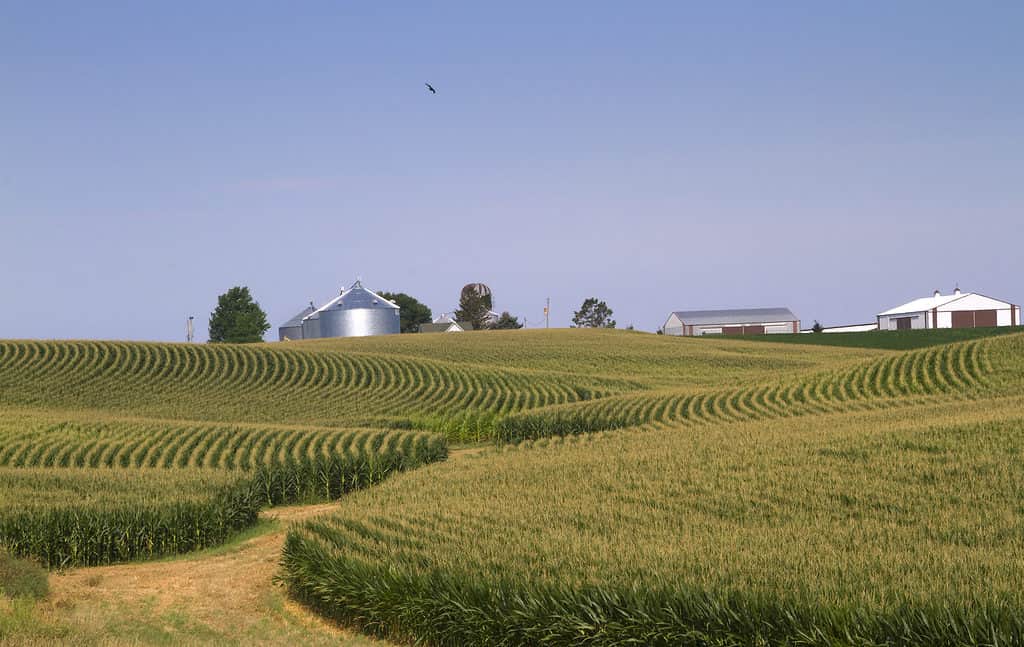Corn is an edible grain first domesticated over 10,000 years ago in Mexico. Christopher Columbus introduced it to Europe, and it has gone on to become the most widely grown crop on the planet. Today, it is not only a vital staple of the human diet, but it is also used as livestock feed, a biofuel source, and an industrial raw material. It is the most widely grown crop in the United States, with 13.7 billion bushels harvested in 2022. Nineteen states produce more than 100 million bushels of corn a year. Read on to find out if your state is on the list.
What is the Corn Belt?

The Midwest has ideal conditions for abundant harvests of corn.
©Maria Sbytova/Shutterstock.com
The corn belt is an area of the Midwestern United States that produces most of the country’s corn crop. It includes Iowa, Illinois, Missouri, and the eastern parts of Nebraska and Kansas. What makes this region so favorable for corn farmers? Deep, nitrogen-rich soil, flat land, steady rainfall, hot days and warm nights during the growing season are all ideal for corn and the country’s second-biggest crop, soybeans. Farms in the region tend to be more than 300 acres in size and family owned.
The 19 Largest Corn Producers in the United States

Iowa is the largest corn-producing state in the country.
©Natalia Kuzmina/Shutterstock.com
The top four largest corn producers in the United States are Iowa, Illinois, Nebraska, and Minnesota. Each of these produces more than one billion bushels a year. Together, they account for more than 54% of the country’s total corn harvest. Another 15 states produce more than 100 million bushels a year.
| State | 2020 Bushels | % of U.S. Total | |
|---|---|---|---|
| U.S. Total | 14,182,479,000 | 100% | |
| 1 | Iowa | 2,296,200,.000 | 16.19% |
| 2 | Illinois | 2,131,200,000 | 15.03% |
| 3 | Nebraska | 1,790,090,000 | 12.62% |
| 4 | Minnesota | 1,441,920,000 | 10.17% |
| 5 | Indiana | 981,750,000 | 6.92% |
| 6 | Kansas | 766,480,000 | 5.40% |
| 7 | South Dakota | 729,000,000 | 5.14% |
| 8 | Ohio | 564,300,000 | 3.98% |
| 9 | Missouri | 560,880,000 | 3.95% |
| 10 | Wisconsin | 516,780,000 | 3.64% |
| 11 | Michigan | 306,406,000 | 2.16% |
| 12 | Kentucky | 253,920,000 | 1.79% |
| 13 | North Dakota | 247,420,000 | 1.74% |
| 14 | Texas | 231,680,000 | 1.63% |
| 15 | Tennessee | 140,250,000 | 0.99% |
| 16 | Pennsylvania | 138,000,000 | 0.97% |
| 17 | Colorado | 122,960,000 | 0.87% |
| 18 | Arkansas | 111,320,000 | 0.78% |
| 19 | North Carolina | 107,350,000 | 0.76% |
- 2020 Bushels: 107,350,000
- % of U.S. Total: 0.76%
The Science of Modern Farming

Technology enables farmers to administer fertilizers and pesticides exactly where they are needed.
©Fotokostic/Shutterstock.com
Corn farming today is truly a precise science. Corn itself is very different from its original form as grown by Native Americans. Selective breeding and genetic engineering have resulted in plants that are hardier and more disease-resistant and have ears that are larger with plumper, juicier kernels. Modern farmers use high technology like drones, GPS, moisture sensors, smart irrigation, terrain contour mapping, and self-driving tractors. Satellite data can help them monitor groundwater and irrigate, fertilize, and administer pesticides and fungicides in the precise areas of the field where they are needed. This not only saves money and maximizes the field’s productivity, but it is also good for the environment, as it prevents over-treatment of the field with chemicals.
How About a Whole Palace of Corn?
If you really love corn, then you really need to visit the Corn Palace in Mitchell, South Dakota. It’s a corny museum covered in murals made of dried “Indian corn” of different colors. Check out the video below for more about this one-of-a-kind attraction.
The photo featured at the top of this post is © Photoongraphy/Shutterstock.com
Thank you for reading! Have some feedback for us? Contact the AZ Animals editorial team.







